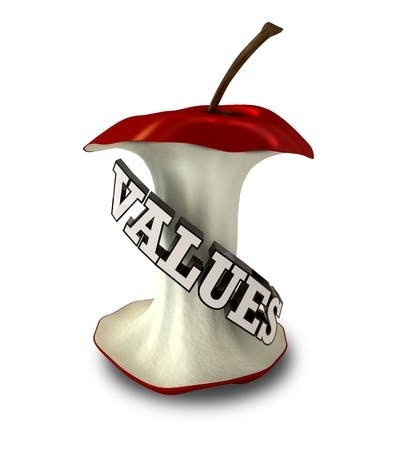Editor’s Note: It’s a TLNT annual tradition to count down the most popular posts of the year. This is No. 39. Our regular content will return on Jan. 5, 2015. Fröhliche Weihnachten!
Core values are traits or qualities that represent deeply held beliefs. They reflect what is important to us, and what motivates us.
In an organization, values define what it stands for and how it is seen and experienced by all stakeholders (customers, employees, service partners, suppliers and communities).
In this organizational context, values are moving from a PR exercise to become the guiding compass, not only for progressive, enlightened organizations but for more well established corporates too.
“Culture will always eat strategy for breakfast”
In reality, values often exist implicitly, outside formal organization processes and, mostly, under the radar of awareness. The commonly adopted behavior in an organization is a representation of the values and creates the culture, the “felt experience” that stakeholders have.
Values impact how the very best thought-out rational processes actually operate in practice. This organization culture is powerful, as Ivan Misner, quoting Peter Drucker, reminds us: “Culture will always eat strategy for breakfast.”
Awareness of values at an organizational level helps employees and organizations to more easily navigate today’s complex, ambiguous business environment.
Articulating core beliefs, traditions and “the way we do things around here” through an explicit set of core values opens things up, empowers employees to make decisions without reference to their line manager for tiny details, ideas flow freely and creativity and innovation take place.
Harnessing the value of core values
How do you ensure that your stakeholders’ experience of your organizational values is explicit andaligned from the boardroom to the front line?
The tone is set by every employee. The leaders model what is important, and are particularly visible in everything they do — people take notice of how they behave.
Yet, each person has influence on others. An organization is a system of loosely connected individuals, and, the organization is only as good as each of the component parts.
We need to turn the lens inwardly if the organization is going to “live” the core values. What are you doing? If you don’t behave as if the core values matter, then others won’t either.
For values to be really cemented in the organization’s culture, everyone must be held accountable for demonstrating the values in their everyday actions. Embedding values is a challenge.
For organizations, identifying values is not enough. Well-written values without good execution can lead to Enron-sized disasters.
Enron would be in good company today; many leadership surveys see corporate values as rhetoric rather than reality, with most employees unaware of their organizations values. And yet, most employees see the potential benefits of having a set of values in the first place, especially if consequences of living and failing to live the core values are explicitly aligned.
So what?
In 2001, UCLA business Prof. Eric Flamholtz discovered a strong positive correlation between cultural agreement (a proxy for values or cultural alignment) and the company’s EBIT (Earnings Before Interest and Taxes). He concludes: “Organizational culture does have an impact on financial performance. It provides additional evidence of the significant role of corporate culture not only in overall organizational effectiveness, but also in the so-called bottom line.”
The changing landscape for business and organizations will arguably bring the importance of values into even sharper focus.
The Internet and social media have brought greater transparency than ever before. As a direct result, authenticity is, and will continue to be, increasingly important.
Some years ago, it was possible for organizations to invest in marketing and PR to tell the story they wanted others to hear, but now it is becoming increasingly difficult to “tell a story.” Organizations are no longer what they say they are but what others say they are and stakeholder perception is formed by the behavior of the people representing the organization.
As the song says, “It Ain’t What You Do (It’s the Way That You Do It), that’s what gets results”.
Exploring tour organizational values
Try this simple exercise to give you some insight into your organizational values.
If your organization were a group of musicians, what group would you be? What would your music be like, your lyrics? What kind of experience would your fans have? How would the band members interact?
And now, what group would you like to be?
This was originally published on CultureUniversity.com and was adapted from the Williams and Whybrow book (2013) THE 31 PRACTICES – Releasing the Power of Your Organization’s Values Every Day, LID Publishing, which is being released in the U.S. in June 2014.
